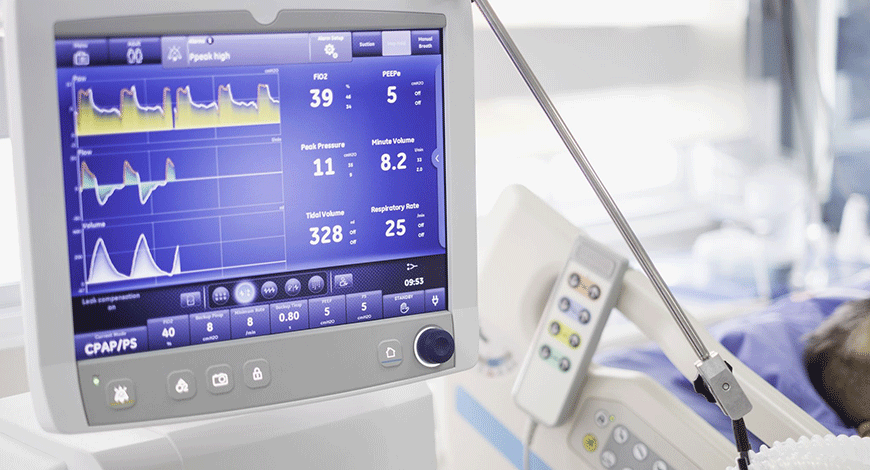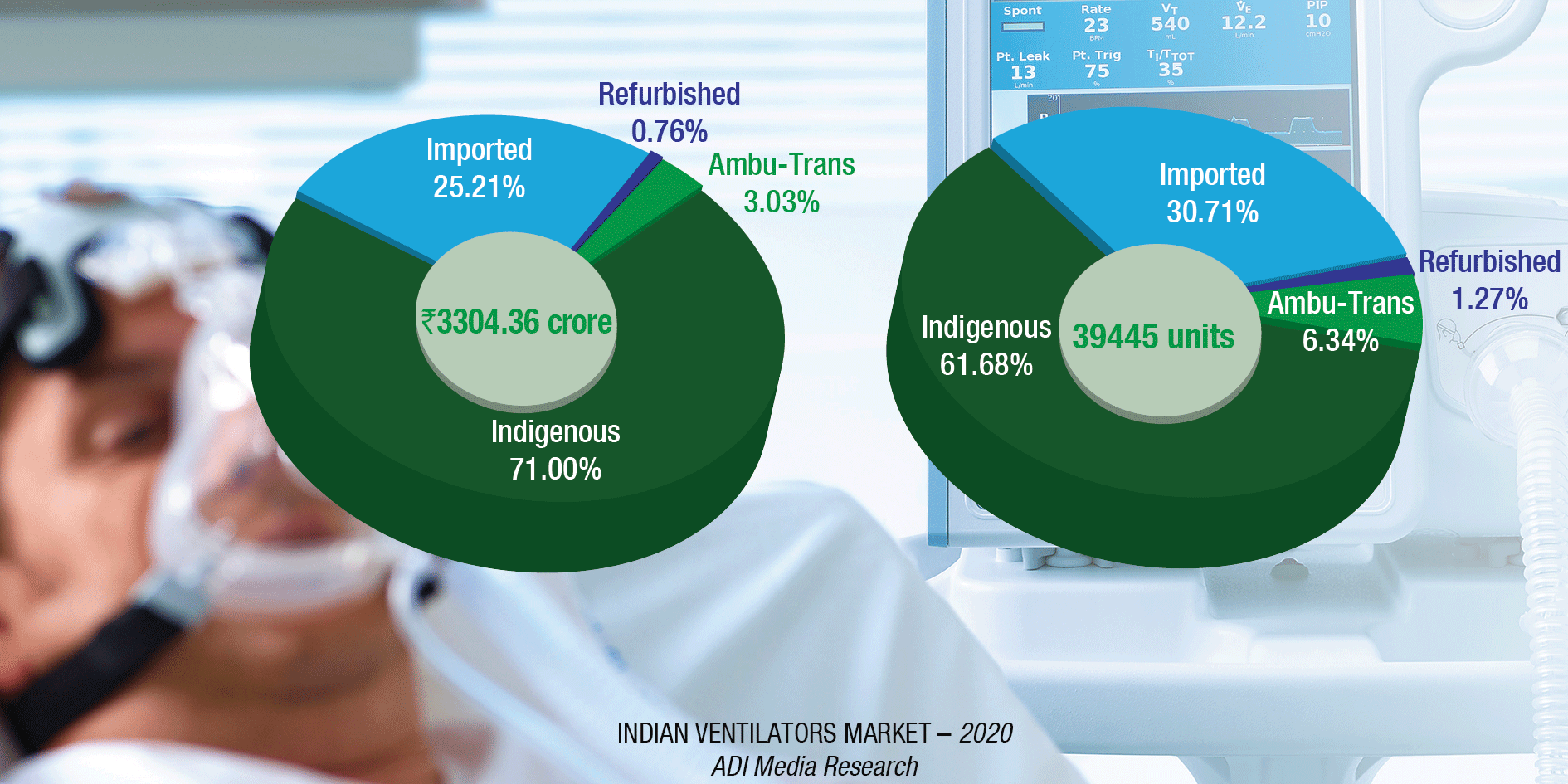Ventilators
Ventilators market looks promising in coming years

The outlook for the global ventilators market looks promising despite an anticipated downturn in demand in 2021.
The global ventilators market is expected to grow steadily to a value of more than USD 1.6 billion over the coming decade – even with sales anticipated to decline in 2021-22. Having been a USD 1.1-billion market prior to the COVID-19 pandemic, a dramatic surge in demand and increased load purchasing led to it peaking at USD 4.8 billion in 2020. And despite anticipation that this demand will level off in 2021, the next few years look promising.
The pandemic’s positive impact on overall respiratory care infrastructures, and the unique partnerships it has created between medical device companies and the engineering sector, are expected to drive steady growth in this space between now and 2030.
The Indian ventilators market in 2020 is estimated at 39,445 units, valued at ₹3304.36 crore. 2020 was a year unlike any other in the history of the Indian ventilators market. The government, under the PM-Cares Fund allocated ₹2000 crore for procurement of this product. The indigenous ventilators segment dominated at 71-percent share by value, and 61.68-percent by volume, a never-before trend. The imported ventilators segment, albeit at an all-time high at 12,113 units, estimated at ₹833 crore, lost its traditional dominance and was a mere 30-percent share by quantity and 25-percent by value. This was more due to the supply chain constraint, since the parent companies had to cater to their respective domestic demand before they made the product available for exports to India.

The leap in procurement in 2020 over 2019 is absolutely mind-boggling. By quantity, the indigenous machines saw an increase by 2333 percent, the imported segment by 122 percent and the total segment by 363 percent. On a similar note, by value, the indigenous machines saw an increase by 7990 percent, the imported segment by 148 percent, and the total segment by 643 percent. The refurbished and ambulatory segments got lost in this maze.
2021 is seeing a different trend. The government that was the large buyer in 2020 is largely staying away, partly as its requirement has been met; there are some supplies still unopened and partly as the coronavirus focus has somewhat shifted to its counterpart, oxygen therapy products.
|
Indian market for imported ventilators |
||
| Major vendors* – 2020 | ||
| Tier I | Tier II | Others |
| Draeger, GE, Hamilton, Aeon Medical, Mindray, and Maquet |
Schiller, Philips, Vyaire, Air Liquide, IMT-Carefusion, & Covidien | BPL, MEK ICS, Hoffrichter GmbH, and Flight Medical |
| *Vendors are placed in different tiers on the basis of their sales contribution to the overall revenues of the Indian ventilators market. | ||
| ADI Media Research | ||
2020 saw, NGOs as a new segment of buyers, and also enterprise buying them as part of their corporate social responsibility (CSR) initiative. For instance, Sir HN Reliance Foundation Hospital, now managing a 650-bed facility at National Sports Club of India, Worli, Mumbai, bought ventilators as it set up its project buying ICU beds and monitors. The Reliance Medical team is also augmenting the number of ventilators across their medical facilities in all the locations. L&T procured and supplied 24 high-end ventilators, Allied Meditec 1700 to SMIMER, civil and other dedicated COVID-19 hospitals in South Gujarat. The company also supplied ventilators to the government hospitals in Madurai, Tuticorin, Tirunelveli, Virudhnagar, and to COVID centers in Chennai. Hindustan Unilever Limited donated 34 ventilators worth ₹4 crore to the Maharashtra government. This included ventilators worth ₹1.5 crore donated to the Municipal Corporation of Greater Mumbai and worth ₹1 crore to the Pune Municipal Corporation.
The rest were sent to civil hospitals in Chiplun, Ratnagiri, and Nashik, where the company has its factories. Hyundai Motor India Foundation, as part of its CSR project Back-to-life purchased 225 BiPap ventilator machines, and expedited deliveries to the most affected states including New Delhi, Maharashtra, Tamil Nadu, Haryana, and Telangana. It also entered into a strategic partnership with Air Liquide Medical Systems to augment production and supply of 1000 ventilators. Maruti Suzuki India also made an arrangement with AgVa Healthcare to scale up production of ventilators to reach a volume of 10,000 units per month. Additionally, it gave 50 ventilators to Haryana government. Other companies are also on a similar spree.
The private hospitals are turning out to be huge buyers in 2021. They are now gearing up and equipping their respective facilities with this machine. As India braced itself for the inevitable third wave, although there was no evidence to suggest that children will be more affected, hospitals across the country stocked up with pediatric ventilators. One instance is that of Mumbai. India’s financial hub built four gigantic centers across the city with special units for the COVID-positive children. The four COVID care centers, with pediatric units, have a capacity to house more than a thousand children along with a parent.
The city has spent tens of millions of rupees to build the pediatric units, and is procuring ventilators, along with monitors and other medical equipment. Rajiv Gandhi Hospital in Pune has been converted itself into a children’s COVID-19 hospital, and another one is expected in Pimpri Chinchwad. Arrangements have been made by the Ahmedabad administration for pediatric ventilators for neonatal intensive care units (NICU) and pediatric intensive care units (PICU) at government hospitals. More than 350 ventilators for children had been ordered at Chacha Nehru Hospital, Indore. The list was huge, how many actually were procured is yet to be documented.
The vendors have been more than ready with supplies. They had huge inventories piled up, and some were staring at a deep financial crisis. Before the pandemic struck in March 2020, the segment had eight manufacturers with an annual capacity to supply 3360 ventilators.
COVID crisis saw nine more players enter the field, raising the manufacturing capacity to 396,260 a year. A few months into the pandemic and India had sizable orders for ventilators from the US, countries in Europe, and others like Russia, Poland, and Brazil. But there was a blanket ban on exports. By the time the ban was lifted in December 2020, these orders had dried up and countries like China had flooded world markets.
The COVID-19 pandemic was initially typified with worldwide calls for more ventilators, creating unique partnerships with medical devices companies and the engineering sector. Non-medical manufacturers, such as some automotive makers, temporarily shifted their focus to developing ventilators by cooperating with current medical manufacturers.
The most successful partnerships were between existing ventilator manufacturers and large engineering companies, through the expansion of manufacturing scale for existing or slightly modified versions of existing approved ventilators. These collaboration experiences will accelerate the implementation of new technology, such as 3D-printing in the medical industry.
The spotlight on ventilators during the pandemic also attracts researchers’ attention. There were many creative ideas, such as negative-pressure ventilation and automated bag valve mask ventilators. Many research facilities, such as NASA have developed COVID-19 ventilators. Although most of the prototypes have not been used in clinical practice during the pandemic, continuous innovation will improve the devices and clinical outcomes.
In the near future, more advanced functions and compact sizes of the modern ventilators will enable them to effectively ventilate all patients in all settings, invasively or non-invasively.
To ensure optimum respiratory care, smart ventilators will better adapt to each different individual’s situation and a patient’s changing condition. This will not only reduce complications and sedation but also greatly increase patient comfort and wean patients earlier.











